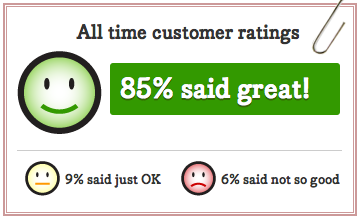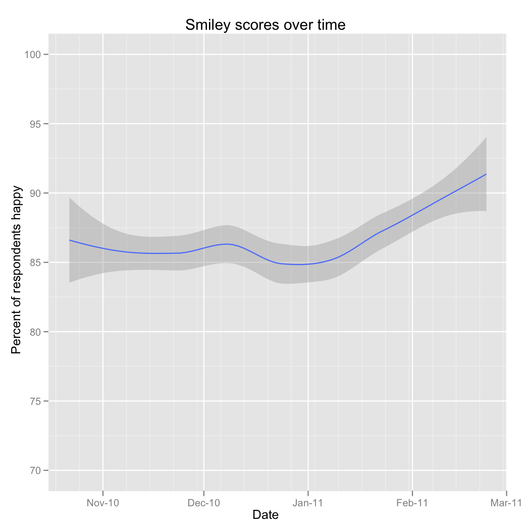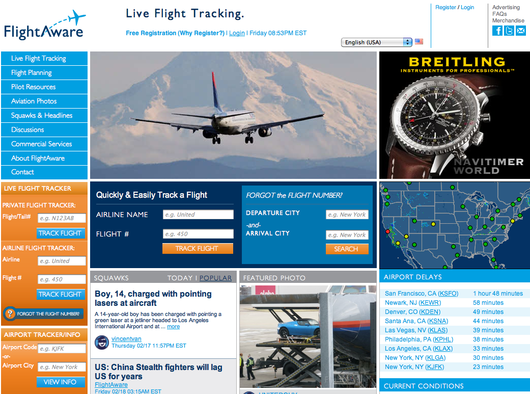The fairest rules are those to which everyone would agree if they did not know how much power they would have.
Bootstrapped, Profitable, & Proud: FlightAware
 In late 2004, Daniel Baker (right) was a newly minted private pilot flying Cessna 172s around the country. “I wanted my friends and family to be able to track my flights just as they could if I were flying on a commercial airline,” explains Baker. “I may have been piloting the aircraft myself, but I still needed a ride once I landed. There were a few commercial products that provided this service for around $1,000 a month, but that wasn’t a realistic solution for friends and family. I got in touch with the FAA and after learning a bit about working with the government, managed to obtain a feed of the live flight data.”
In late 2004, Daniel Baker (right) was a newly minted private pilot flying Cessna 172s around the country. “I wanted my friends and family to be able to track my flights just as they could if I were flying on a commercial airline,” explains Baker. “I may have been piloting the aircraft myself, but I still needed a ride once I landed. There were a few commercial products that provided this service for around $1,000 a month, but that wasn’t a realistic solution for friends and family. I got in touch with the FAA and after learning a bit about working with the government, managed to obtain a feed of the live flight data.”
Baker then started working during his free time to build an infrastructure for processing the data and a web interface. He recruited friends Karl Lehenbauer and David McNett to help out too. After six months they released FlightAware.com to the public. The site “took off like wildfire” within the pilot community, according to Baker.
“Before long, the phone started ringing,” he says. “A guy called asking for a data report. I was so excited that someone was interested in us that I produced an Excel file for him for free. The next day, someone called asking for a similar project and I charged him $200, which he gladly paid. Later that day, another call, and I charged $500, which was no problem. It didn’t take long to realize that we had stumbled into a real business. It also didn’t take long for the call volume to encourage me to hire someone to answer the phone.”
The rapid growth led to hardware and bandwidth expenses. At first, Baker used his credit card to cover the costs. He says, “Initially, I bought a server for $6K and just put it on my AmEx. I figured it would all work out; I did the math and at our October 2005 run rate of $20/day, I’d be able to pay myself back in just under a year. I was OK with that. Quickly, it became clear that we were going to grow a little faster than that and we all chipped in for more hardware, some graphic design, and bandwidth. All in all, we only fronted about $25K before we broke even in March of 2006. And we have been profitable ever since then.”
The inside scoop on flights
Now, the site is a full fledged hit. Unlike airline-centric sites that simply pass on the flight status straight from the airlines, FlightAware.com shows the real-time, inside scoop from air traffic control data and other operational data sources. This includes radar positions, flight plan re-routes, and weather on interactive maps, delay projections, trends, and more. According to Baker, the site serves over two million people per month, split about 50/50 between airline and private flights. It displays over 150M ads every month.
On the Front Lines, In the Trenches
Everyone is there to support a sale
Gordon Segal, founder and former CEO of Crate and Barrel, has the belief that each person in the corporation is there to support a sale in the store. Think about that for a second. When he says each person he isn’t just talking about the stockroom and people wearing the iconic black aprons. He’s also thinking about those designers and programmers at the corporate headquarters.
I was a designer at Crate and Barrel before 37signals. In fact, I was there for 7.5 years which is like 14 internet years right? Before Crate I was working the rounds for several years at interactive agencies during the boom times of the late 90’s. I bring this up because I worked really hard to develop skills and experience to escape those minimum wage retail jobs.
A humbling experience
Human Resources said that I had to work for 2 weeks at a retail store when I was first hired as a Graphic Designer. I thought to myself, “Bullshit!” They want to pay me a to work in a retail store? I want to start designing and making all the great things I’ve been dreaming about during the interview process! Note that I wouldn’t get to see my desk at the corporate headquarters for 2 weeks either.
I started my first day as a Graphic Designer at the North and Clybourn retail store in Chicago — complete with khakis and black apron. It was an incredible and humbling experience. I was completely out of my element. My world was MacOS not walking the floor chatting with customers. If you’re ever been in a Crate and Barrel store you’ll know that they’re wonderful to browse yet terrible to find things quickly for a high maintenance customer.
During those 2 weeks in the store I worked in every department: Kitchenwares, Furniture, Basics (everyday stuff), Dinnerware, etc. I saw a customer try to return a set of glasses he actually bought from Target. I saw happy engaged couples zapping merchandise around the store to put on their gift registry. I saw a furniture salesperson make a $20,000 sale in a few minutes. I was seeing how the business was run on the front lines, in the trenches, out of my element.
On being a better Designer
When I was in college I believed that Design can change the world. I still believe that, but I’ve become more of a pragmatist. Let’s face it, most designers out there design something to sell something else.
You can be a better designer by copying someone’s style or reading design theory books. I, however, believe the best way to be a better designer is to be on the front lines, in the trenches. Graphic Design at its basest level is to communicate something visually. The best way to communicate something better is to understand what customers need or what they’re looking for.
When I was at the Crate and Barrel store helping a woman find a set of drinking glasses I had a short conversation with her about what sort of glasses she was interested in. There are so many glasses at the Crate. In this 5 minute conversation I helped her hone in on the right glasses. Making this one $9.99 sale taught me loads more than a graphic design book had ever done. I remembered this later as I designed the UI for the website.
Customer service and support
Recently we’ve really locked in our customer support workflow here at 37signals. It’s really easy for anyone to jump in and start interacting with customers — answering their questions and helping them in times of desperation. All of the designers (Jason and David too!) are starting to interact directly with our customers. I dig that.
I know that the more sales questions I answer the better designer I’ll be. I’m on the front lines and in the trenches.
Quora on Designing an Organization That Designs Better Products
I was completely nodding my head throughout this piece on what it means to do great product design. It’s written by Rebekah Cox, Product Designer and Manager at Quora.
Also check out her walkthrough of the design process for Quora.
If FaceTime is ever going to become anything resembling universal, putting an extra price tag on already pricy hardware could hamstring the whole effort.
Gizmodo on Apple charging $1.00 for the Facetime Mac app. (note: Americans are spoiled)
A look at Smiley by the numbers
Since we launched a public window on Smiley a few weeks ago, over 20,000 people have visited it to see how we’re doing against our goal of making customers happy, not just satisfied.
I recently took a look at responses to Smiley since we started using it last fall. The whole point of exposing Smiley publicly was to encourage transparency, and I’d like to continue that by sharing the same results I shared with everyone here. I’ll give the results first; for those of you interested in the “how”, I’ll share details at the end.
What we’re learning from Smiley
About 30% of people who write to support end up rating our response. We’re very happy with 30% – that’s quite high for a completely optional survey.
Across all of those responses, our report card looks like this:

In my mind, the key metric is really the portion that said their interaction was great. If someone said it was just ok or if they said not so good, those both indicate something we could be doing differently.
I dug a little deeper to understand how happiness varies:
- More people rated their interaction as “great” in 2011 than 2010 (87% vs 83%). This has been climbing over the last two months as well.

- People whose tickets are fully resolved within a day of submitting them are more likely to be happy than those that took longer (87% vs. 81%; in the last six months, we’ve resolved 84% of our tickets within a day of submission, including weekends).
- Happiness is pretty consistent across products – ranging from a low of 83% saying great to a high of 86%
- Happiness doesn’t vary much by the specific plan someone is on. Elite Suite customers are just as happy as customers using a free version.
Aside from rating the experience great, ok, or not so good, we allow people to leave open ended comments. 59% of people have ended up leaving comments so far. I decided to take a look at what people are saying:
The average comment is 12 words. The most common words people used in their responses were: quick, thanks, answer, fast, friendly, problem, question, reply, time, great, clear, helpful, issue, support, service, prompt, good, solution, feature, solved, and timely.
I also took a special look at the written comments of people who weren’t happy with their support interaction. More of these people wrote comments (63%) and their comments were twice as long as average. Their comments connect well with what we suspected – people appreciate getting clear answers right away, and when we aren’t able to make someone happy, it’s often because of a feature request that we aren’t able to commit to immediately.
We’re happy to see happiness increasing over time, and have a bunch of ideas in the works to keep boosting this. I hope you keep watching with us at the 37signals Customer Support Happiness Report.
If you’re curious how I did this analysis, read on…
Continued…From Apple to Zipcar, new jobs on the Job Board and web design firms on Sortfolio
View all of the jobs and internships at the 37signals Job Board.
Programming Jobs
Zipcar is looking for a Software Engineer in Cambridge, MA.
Posterous is looking for an Rails Developer in San Francisco, CA.
charity: water is looking for a Software Developer in New York, New York.
Red Ant is looking for a Rails developer in Sydney, Australia.
View all Programming Job listings.
Design Jobs
Apple Inc. is looking for a MobileMe Senior User Experience Designer in Cupertino, CA.
eMusic.com is looking for an User Experience Designer in New York, NY.
The E.W. Scripps Company is looking for a User Experience Specialist in Knoxville, TN.
Yelp is looking for a UI Designer in San Francisco, CA.
The Job Board also has iPhone Developer Jobs, Customer Service/Support Jobs, Business/Exec Jobs, and more.
Sortfolio Web Designers
doejo is headquartered in Chicago and has a typical project budget of $25,000-$50,000.
Clarity is headquartered in Austin and has a typical project budget of $10,000-$25,000.
Imulus is headquartered in Denver and has a typical project budget of over $50,000.
Artenergy is headquartered in San Francisco and has a typical project budget of $10,000-$25,000.
The end of the IT department
When people talk about their IT departments, they always talk about the things they’re not allowed to do, the applications they can’t run, and the long time it takes to get anything done. Rigid and inflexible policies that fill the air with animosity. Not to mention the frustrations of speaking different languages. None of this is a good foundation for a sustainable relationship.
If businesses had as many gripes with an external vendor, that vendor would’ve been dropped long ago. But IT departments have endured as a necessary evil. I think those days are coming to an end.
The problem with IT departments seems to be that they’re set up as a forced internal vendor. From the start, they have a monopoly on the “computer problem” – such monopolies have a tendency to produce the customer service you’d expect from the US Postal Service. The IT department has all the power, they’re not going anywhere (at least not in the short term), and their customers are seen as mindless peons. There’s no feedback loop for improvement.
Obviously, I can see the other side of the fence as well. IT departments are usually treated as a cost center, just above mail delivery and food service in the corporate pecking order, and never win anything when shit just works, but face the wrath of everyone when THE EXCHANGE SERVER IS DOWN!!!!!
At the same time, IT job security is often dependent on making things hard, slow, and complex. If the Exchange Server didn’t require two people to babysit it at all times, that would mean two friends out of work. Of course using hosted Gmail is a bad idea! It’s the same forces and mechanics that slowly turned unions from a force of progress (proper working conditions for all!) to a force of stagnation (only Jack can move the conference chairs, Joe is the only guy who can fix the microphone).
But change is coming. Dealing with technology has gone from something only for the techy geeks to something more mainstream. Younger generations get it. Computer savvyness is no longer just for the geek squad.
You no longer need a tech person at the office to man “the server room.” Responsibility for keeping the servers running has shifted away from the centralized IT department. Today you can get just about all the services that previously required local expertise from a web site somewhere.
The transition won’t happen over night, but it’s long since begun. The companies who feel they can do without an official IT department are growing in number and size. It’s entirely possible to run a 20-man office without ever even considering the need for a computer called “server” somewhere.
The good news for IT department operators is that they’re not exactly saddled with skills that can’t be used elsewhere. Most auto workers and textile makers would surely envy their impending doom and ask for a swap.
What happens after Yahoo acquires you
Whether it’s Flickr, Delicious, MyBlogLog, or Upcoming, the post-purchase story is a similar one. Both sides talk about all the wonderful things they will do together. Then reality sets in. They get bogged down trying to overcome integration obstacles, endless meetings, and stifling bureaucracy. The products slow down or stop moving forward entirely. Once they hit the two-year mark and are free to leave, the founders take off. The sites are left to flounder or ride into the sunset. And customers are left holding the bag.
Flickr was acquired by Yahoo in March ‘05 for $35M
The Flickr announcement of the deal said, “We’ll be working with a bunch of people that Totally Get Flickr and want to preserve the community and the flavor of what is here. We’re going to grow and change, but we’re in it for the long haul, with the same management and same team.”
But in 2008, co-founders Caterina Fake and Stewart Butterfield both left the company. In 2009, many engineers from the service were laid off or left on their own.
Meanwhile, Facebook kept taking a growing share of photo traffic. Yahoo’s top executives barely mentioned Flickr publicly (and few of them actually have a public Flickr account). Decision-making at Flickr slowed because of bureaucracy. “We just missed some opportunities that we could have tried if we were independent and raised our own money,” Butterfield said. “Who knows what would have happened?” He said ideas to give more visibility to photos of breaking news and ideas for international expansion never got off the ground.
Ex-Flickr Architect Kellan Elliott-McCrea also blamed the Yahoo bureaucracy for slowing the Flickr team down. “Roughly 15% of any of the large projects they (we?) tackled over the last few years (internationalization, video, various growth strategies, etc) went into building the feature. 85% was spent dealing with Yahoo,” he said. According to a worklog he kept in 2008-2009, 18 meetings scheduled over a 9 month period discussed why Flickr’s API was poorly designed and when it’d be shut down and migrated to the YOS Web Services Standard. He said, “That kind of stuff slows you down. Especially when you’re being starved for resources.”
On the plus side, Yahoo says it’s still “absolutely committed” to Flickr. And Butterfield says that although Facebook is grabbing more mainstream photo sharers, Flickr continues to be the leader among photo enthusiasts.
Delicious was acquired by Yahoo in December ‘05 for $15-20M
Delicious’ Joshua Schachter announced the deal saying, “Together we’ll continue to improve how people discover, remember and share on the Internet, with a big emphasis on the power of community. We’re excited to be working with the Yahoo! Search team – they definitely get social systems and their potential to change the web.” Meanwhile, Yahoo promised “to give Delicious the resources, support, and room it needs to continue growing the service and community.”
But then the app seemed to go stagnant. Traffic dropped. Schachter claims he was stripped of responsibilities and employees within a year after acquisition. “My boss didn’t agree with my technical design or product direction,” said Schacter. “It was phrased more like ‘you should be the idea guy, we’ll find other people to run engineering for you;’ the guy he decided would be good was ultimately him. However, he mostly spent all his time on Answers and none on Delicious, so it was more like absentee landlordism.”
Schacter left Yahoo when his contract was up, in June of 2008. “I was largely sidelined by the decisions of my management,” he said after leaving. “It was an incredibly frustrating experience.”
Recently, a leaked slide revealed Yahoo might be planning to “sunset” the app. Schachter vented, “[Yahoo!] killed a lot of good startups, wasted a lot of engineers’ time, etc. Perhaps I spent too much time inside that particular sausage factory. I wish I had not sold it to them. The cash and freedom do not even come close; I would rather work on a big, popular product.”
MyBlogLog was acquired by Yahoo! in January ’07 for $10M
Upon acquisition, Chad Dickerson, senior director of Yahoo Developer Network, said, “We don’t plan on making any immediate changes to the MyBlogLog Web site, distribution or branding. We want to encourage and not disrupt the continued growth of the MyBlogLog community and foster the innovation that has already made MyBlogLog an indispensable part of [users’] lives.”
The obsession with next
The tech world is obsessed with what’s next. It has become so used to the constant flow of new products and new companies that newness itself has been placed on a pedestal. But outside of a few breakthroughs here and there, most things that are good are good because they got there slowly.
That’s why it always irks me when you hear entrepreneurs being asked “what’s next for you”, usually with the implication of either “what new product are you going to put out” or “what new company will you start next”. Not what improvements or tweaks are you going to make to what you have. All I can think of is the old Spolsky article Good Software Takes Ten Years.
I understand that reporters and outsiders aren’t interested in hearing about how you made this thing a little better or that thing a little smoother. They want fireworks: complete rewrites, massive new features, something brand-new. To people who actually use the product, though, that little tweak you made to remove a nagging problem is often way more important than something big and flashy.
It’s not only good software that takes a decade to develop, good companies do too. If you agree that’s true, it follows that you wouldn’t want promising entrepreneurs to go chasing waterfalls before they know how to paddle in the pond. Or something like that.
I guess what I’m trying to say is that I want to see evolution get a chance to work its magic, but if great products and companies keep getting abandoned or bought after 3-5 years, there’ll be less of that. And that’s a damn shame.





